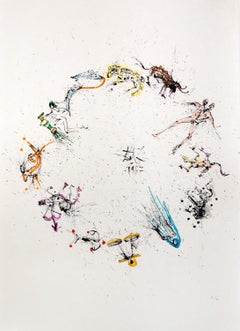Lithograph Prints and Multiples
1940s Surrealist Lithograph Prints and Multiples
Lithograph
1960s Surrealist Lithograph Prints and Multiples
Lithograph
Late 20th Century Surrealist Lithograph Prints and Multiples
Lithograph
Mid-20th Century Surrealist Lithograph Prints and Multiples
Lithograph
1960s Surrealist Lithograph Prints and Multiples
Ink, Lithograph
1960s Surrealist Lithograph Prints and Multiples
Lithograph
1970s Surrealist Lithograph Prints and Multiples
Gold Leaf
1970s Surrealist Lithograph Prints and Multiples
Lithograph
1960s Surrealist Lithograph Prints and Multiples
Lithograph
1970s Surrealist Lithograph Prints and Multiples
Lithograph
1970s Surrealist Lithograph Prints and Multiples
Lithograph
1970s Surrealist Lithograph Prints and Multiples
Lithograph
1960s Surrealist Lithograph Prints and Multiples
Lithograph
1960s Surrealist Lithograph Prints and Multiples
Lithograph
1960s Surrealist Lithograph Prints and Multiples
Lithograph
1960s Surrealist Lithograph Prints and Multiples
Lithograph
1960s Surrealist Lithograph Prints and Multiples
Lithograph
1970s Surrealist Lithograph Prints and Multiples
Lithograph
1960s Surrealist Lithograph Prints and Multiples
Lithograph
1970s Surrealist Lithograph Prints and Multiples
Lithograph
1980s Surrealist Lithograph Prints and Multiples
Lithograph
Mid-20th Century Surrealist Lithograph Prints and Multiples
Lithograph
1950s Surrealist Lithograph Prints and Multiples
Lithograph
20th Century Surrealist Lithograph Prints and Multiples
Paper, Lithograph
1970s Surrealist Lithograph Prints and Multiples
Lithograph
1970s Surrealist Lithograph Prints and Multiples
Lithograph
1970s Surrealist Lithograph Prints and Multiples
Lithograph
1950s Surrealist Lithograph Prints and Multiples
Lithograph
1950s Surrealist Lithograph Prints and Multiples
Lithograph
1970s Surrealist Lithograph Prints and Multiples
Lithograph
Mid-20th Century Surrealist Lithograph Prints and Multiples
Paper, Lithograph
1990s Surrealist Lithograph Prints and Multiples
Lithograph
Mid-20th Century Surrealist Lithograph Prints and Multiples
Paper, Lithograph
1960s Surrealist Lithograph Prints and Multiples
Lithograph
Mid-20th Century Surrealist Lithograph Prints and Multiples
Lithograph
1990s Surrealist Lithograph Prints and Multiples
Lithograph
Late 20th Century Surrealist Lithograph Prints and Multiples
Lithograph
Late 20th Century Surrealist Lithograph Prints and Multiples
Lithograph
1950s Surrealist Lithograph Prints and Multiples
Lithograph
1960s Surrealist Lithograph Prints and Multiples
Lithograph
1980s Surrealist Lithograph Prints and Multiples
Lithograph
1950s Surrealist Lithograph Prints and Multiples
Lithograph
1960s Surrealist Lithograph Prints and Multiples
Lithograph
1980s Surrealist Lithograph Prints and Multiples
Lithograph
1990s Surrealist Lithograph Prints and Multiples
Lithograph
1960s Surrealist Lithograph Prints and Multiples
Lithograph
1970s Surrealist Lithograph Prints and Multiples
Lithograph
1970s Surrealist Lithograph Prints and Multiples
Lithograph
1980s Surrealist Lithograph Prints and Multiples
Lithograph
1970s Surrealist Lithograph Prints and Multiples
Lithograph
Mid-20th Century Surrealist Lithograph Prints and Multiples
Paper, Lithograph
1990s Surrealist Lithograph Prints and Multiples
Lithograph
20th Century Surrealist Lithograph Prints and Multiples
Lithograph
1950s Surrealist Lithograph Prints and Multiples
Lithograph
1980s Surrealist Lithograph Prints and Multiples
Lithograph
1960s Surrealist Lithograph Prints and Multiples
Lithograph
1990s Surrealist Lithograph Prints and Multiples
Lithograph
1990s Surrealist Lithograph Prints and Multiples
Lithograph
Vintage Lithographs and Other Prints for Sale on 1stDibs
Buying art and design is one thing. Collecting it is quite another. Whether you’re looking to add a focal point to your living room or you’re introducing a new acquisition to an already thriving collection of art, the range of vintage lithographs and other fine art prints on 1stDibs is waiting for you.
The lithographic process begins by drawing on or painting on a stone surface with an oil-based substance, such as a greasy crayon or tusche (an oily wash). The stone is then covered with water, which is repelled by the oily areas. Oil-based ink is then applied to the wet stone, adhering only to the oily image. The stone is then covered with a sheet of paper and run through a press.
Lithographs tend to be more painterly than other printing techniques such as woodcut printmaking and drypoint, and many postwar and contemporary painters have collaborated with lithographic workshops to push their practices in new directions. The collection of vintage lithographs on 1stDibs includes works by Marc Chagall, Joan Miró, Peter Max, Jasper Johns and other artists.
Groundbreaking print studios like Gemini began to crop up in the mid-20th century. These included Tamarind, first founded as a lithography shop in Los Angeles; ULAE on New York’s Long Island; and Crown Point Press in San Francisco. The timing was due to the fact that many artists had developed a taste for printmaking during the Great Depression via the Works Progress Administration (WPA), which opened print shops for unemployed artists to help create useful and uplifting messages that could be widely disseminated.
Find vintage lithographs and other types of prints for sale on 1stDibs.





